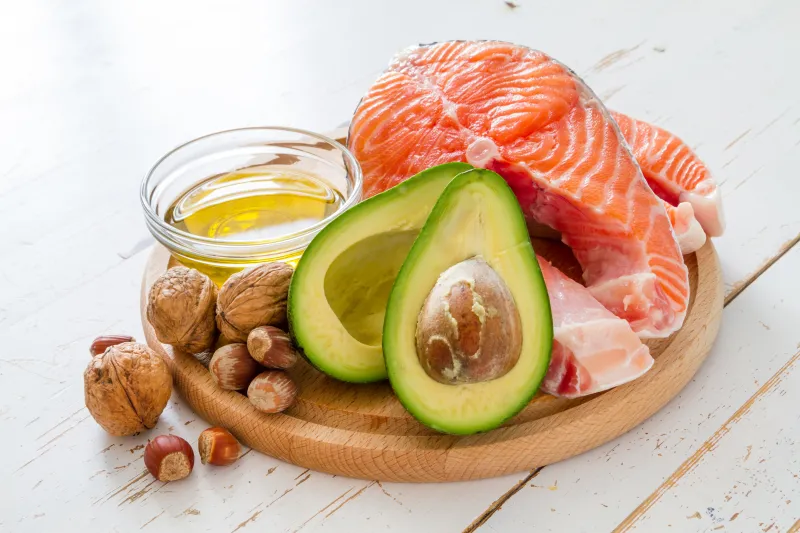At a glance
Keto flu occurs when the body shifts from using carbohydrates to fat for energy, which can trigger temporary flu-like symptoms. These short-lived side effects are linked to changes in metabolic function, electrolyte balance, and nutrient intake. Understanding what drives keto flu and how to address it can help you manage discomfort and support a smoother transition into a ketogenic diet.
Keto is a low-carb, high-fat diet that promotes weight loss, supports healthy blood sugar levels, and may reduce the risk of cardiovascular and neurodegenerative disease.
However, those new to keto can experience side effects similar to the flu virus, including body aches, fatigue, and brain fog. These symptoms are often referred to as keto flu and are a common phenomenon for those adapting to a high-fat diet.
Learn what causes the keto flu and discover how to improve symptoms quickly.
What is the keto flu?
The average American adult consumes between 225 and 325 grams of carbohydrates daily. However, ketogenic diets require no more than 20 to 50 grams per day.
The keto flu, also known as the carb flu, is a common side effect of this dramatic reduction in carbohydrate intake, which can trigger symptoms similar to the flu, though it’s not a virus.
This phenomenon typically results from the body adapting to the profound metabolic changes caused by switching from using glucose as a fuel source to burning fat to generate energy.
The breakdown of fat releases large amounts of high ketones, a group of organic acids that serve as a highly effective energy source. When ketones start to fuel your body, you enter the metabolic state of fat-burning, also known as ketosis.
Your cells may have to adapt to using ketones as a primary fuel source instead of relying on carbohydrates, which can lead to temporary side effects.
Watch the video below to learn how to overcome the keto flu.
Causes
B vitamin deficiencies and imbalanced electrolytes, particularly sodium and potassium, are the most common causes of keto flu symptoms.
Most people obtain B vitamins from fortified grains, legumes, and fruits and vegetables, including watermelons, apples, and potatoes.
Many vitamin B-rich foods aren’t keto-friendly, and keto dieters often make the mistake of not consuming enough leafy green vegetables when transitioning to this new diet, potentially increasing the risk of deficiencies.
Carbohydrates and sugars promote water retention, and switching to a low-carb, high-fat diet can lead to dehydration and electrolyte loss without optimal salt and potassium intake.
Keto dieters who previously consumed large amounts of carbohydrates, sugar, and ultra-processed foods may experience more intense keto symptoms and may take longer to become fat-adapted.
High-carb diets stimulate the storage of sugars in the form of glycogen in muscle tissue and the liver. Before your body can fully adapt to fat-burning, glycogen stores must be depleted. This explains why those who consumed excess carbs before starting keto are at higher risk of keto flu symptoms.

Symptoms
When the body enters ketosis, it undergoes a major metabolic change, burning fat for fuel instead of using sugars and carbohydrates.
Carbohydrate withdrawal can cause various side effects as the body searches for alternative energy sources in the absence of sugar.
According to a study published in StatPearls, common keto flu symptoms include:1
- Nausea
- Dizziness
- Fatigue
- Headaches
- Constipation
- Diarrhea
In addition, starting a keto diet may also trigger symptoms such as:
- Bad breath
- Rashes
- Insomnia
- Brain fog
- Carb and sugar cravings
- Irritability
Those experiencing keto flu symptoms may also experience decreased exercise tolerance and muscle soreness.

Keto flu remedies and prevention
The keto flu can cause uncomfortable symptoms lasting a few days to weeks. Luckily, various natural remedies can lessen or avoid these side effects altogether.
Here are seven ways to prevent or minimize symptoms of the keto flu.
1. Take vitamin B-complex
The B vitamin complex is a group of eight water-soluble vitamins that play a critical role in energy production, brain function, nerve signaling, and hormonal balance.
Common sources of B vitamins, such as fortified cereals, whole grains, and fruits, aren’t keto-friendly, and switching to keto could trigger or worsen deficiencies.
To maintain optimal vitamin B levels, it’s vital to prioritize vitamin B-rich foods such as leafy greens, avocados, broccoli, grass-fed meat, and eggs. This helps reduce the risk of common keto symptoms, including irritability, keto rash, and brain fog.
Supplementing with unfortified nutritional yeast is also an excellent strategy to boost B vitamins. Nutritional yeast has a cheesy, nutty flavor that goes well with many keto-approved meals such as salads, soups, and roasted vegetables.
2. Replenish electrolytes
On a high-carb diet, glycogen is deposited in muscle tissue and liver cells. Glycogen is bound to water, and according to a study published in the European Journal of Applied Physiology, one gram of glycogen requires at least three grams of water.2
Limiting sugar and carb intake triggers glycogen release and water loss. This results in increased urination and can quickly deplete electrolytes, which can be linked to keto flu symptoms such as muscle weakness, headaches, fatigue, and insomnia.
“Many keto flu symptoms result from low potassium and sodium levels,” explains Dr. Berg. “Starting keto causes electrolyte loss, and it’s important to drink when you’re thirsty and ensure adequate electrolyte intake to minimize keto flu symptoms.”
Ensure you’re replenishing sodium by seasoning food with sea salt to taste or adding small amounts to your water.
Potassium can be obtained from many keto-approved foods such as avocados, leafy greens, tomatoes, cucumbers, and zucchini.
Alternatively, you can promote balanced electrolyte levels by taking a sugar-free electrolyte powder. However, avoid drinking sports drinks or pre-mixed electrolyte solutions that often contain sugars, synthetic dyes, and artificial flavors.
Sugary sports drinks will kick you out of ketosis. In addition, artificial dyes, such as Red 40, have been linked to cancer, attention deficit hyperactivity disorder (ADHD), migraines, depression, and other harmful effects.

3. Stay hydrated
The keto diet causes the body to excrete stored water, which increases the risk of dehydration. Lack of adequate body fluids can worsen symptoms such as headaches, fatigue, and muscle cramps.
However, drinking too much water can lead to excessive electrolyte loss, which can exacerbate dehydration. Drink when you’re thirsty and replenish electrolytes to avoid worsening symptoms.
4. Adjust vegetable intake
Many keto dieters make the mistake of eating too much protein and not enough vegetables, which can cause bad breath, a common side effect of adapting to a high-fat diet.
It’s recommended to consume around 7 to 10 cups of vegetables daily and aim for between 3 to 6 ounces of protein per meal.
Eating plenty of vegetables can help counter the odor caused by the breakdown of ketones into acetone, which emits a smell similar to nail polish remover.
However, consuming too many vegetables can lead to constipation, especially in those with an imbalanced gut microbiome. Bacteria in the gut help digest dietary fiber, which promotes digestion processes and helps reduce constipation.
If you’re experiencing constipation, you may not have enough beneficial microbes to break down large volumes of vegetables. Switching to fermented foods like sauerkraut, pickles, or kimchi can help the gut microbes transition to the ketogenic diet and digest vegetables more easily.

5. Eat enough fat and calories
If you’re using the ketogenic diet to lose weight, you may be tempted to lower your calorie intake. However, not meeting your caloric needs can lead to fatigue, irritability, and cravings.
Consuming enough healthy fats is vital for fueling your body as it transitions to burning fat. Ensure you’re eating until satisfied, and include a source of healthy fat with each meal.
Here are keto-friendly fat sources:
- Medium chain triglycerides (MCTs)
- Coconut and olive oil
- Avocadoes
- Fatty fish such as salmon, sardines, and tuna
- Flax and chia seeds
- Almonds
In addition, consuming enough fat can curb cravings for sugar and carbs, a common symptom of adapting to keto.
A study published in Obesity found that individuals following a low-carb, high-fat diet experienced fewer cravings than those on a low-fat diet.3
6. Reduce dairy
Constipation is a common side effect of starting a ketogenic diet. New dieters often increase cheese consumption and eat minimal vegetables, which can cause constipation due to the lack of fiber.
Lactose or casein intolerance can also irritate the gastrointestinal tract and contribute to intestinal permeability or leaky gut, which can lead to breakouts or rashes in those sensitive to dairy.
A study published in Molecules found that “…intestinal hyperpermeability may allow the entry of harmful microorganisms, toxins, or undigested food particles through the junctions of the intestinal epithelium, reaching the bloodstream and being able to affect the hormonal, immune, nervous, respiratory or reproductive systems.”4
7. Exercise
Low-intensity exercise such as walking, biking, stretching, or swimming can help burn through glycogen reserves as your body transitions to ketones, which can improve keto flu symptoms faster.
A study published in Nutrition Reviews found that glycogen stores deplete from the muscles and liver during exercise, with longer and more intense sessions having the greatest effects.5
However, if you’re experiencing muscle weakness, muscle cramps, or fatigue on the ketogenic diet, it’s best to avoid strenuous exercise until symptoms of keto flu improve.

How long does the keto flu last?
How long does the keto flu last? This depends on factors such as potential pre-existing nutrient deficiencies, prior dietary habits, and the amount of glycogen stored in muscle and liver tissues.
Most keto dieters develop keto flu symptoms around three days after reducing their carbohydrate intake. This is approximately when the metabolism begins to switch from glucose to fat as the body’s main energy source.
Carb withdrawal and flu-like symptoms should dissipate within a few days to a week. However, those who followed a high-carb diet before switching to Healthy Keto® may experience symptoms for up to three weeks.
It’s important to note that it may take up to six weeks or longer for the body to become fully fat-adapted.
Key takeaways
- The keto flu is a common side effect of the metabolic shift from using sugar to burning fat for energy and is usually linked to nutrient imbalances.
- Electrolyte imbalances, along with low B-vitamin intake, are common contributors to keto flu symptoms.
- Keto flu symptoms can include nausea, body aches, headaches, fatigue, digestive issues, brain fog, and cravings for sugar and carbs, and may last from a few days to a few weeks.
- Increasing electrolyte intake, staying adequately hydrated, and consuming B-vitamin-rich foods can help ease the transition into ketosis.
- Eating sufficient healthy fats, incorporating plenty of vegetables, and engaging in light exercise can help further support adaptation and alleviate keto flu discomfort.
FAQ
1. What does the keto flu feel like?
Common keto flu symptoms include fatigue, brain fog, headaches, and body aches. When starting the keto diet, dieters may also experience loss of appetite, muscle weakness, chills, and nausea within the first few weeks of following a high-fat diet.
2. How long does it take to get over the keto flu?
Though the time it takes to adapt to ketosis varies, you can expect keto flu symptoms to alleviate within a week or two of starting a ketogenic diet.
Replenishing electrolytes and supplementing with a vitamin B-complex can help reduce keto flu symptoms quicker.
3. What happens on day 3 of keto?
By day three of starting keto, your body will have depleted its glycogen stores and is transitioning to burning fat as a fuel source.
Day three also appears to be the time that most people start to experience keto flu symptoms as they adapt to ketosis.
4. What does going into ketosis feel like?
Once you’re fully keto-adapted, symptoms of the keto flu will improve, and you will likely notice enhanced cognition, mood, and energy levels. You may also experience less inflammation, sleep better, and feel more satisfied after eating.
5. What is the best way to prevent the keto flu?
Proper nutrition is the best way to prevent the keto flu. To avoid nutrient deficiencies, consume seven to ten cups of vegetables and eat plenty of healthy fats.
Additionally, supplementing with a vitamin B-complex and replenishing electrolytes can help prevent common keto flu symptoms, such as headaches, irritability, brain fog, and fatigue.
Sources
- https://www.ncbi.nlm.nih.gov/books/NBK499830/ ?
- https://pubmed.ncbi.nlm.nih.gov/25911631/ ?
- https://www.ncbi.nlm.nih.gov/pmc/articles/PMC3139783/ ?
- https://www.ncbi.nlm.nih.gov/pmc/articles/PMC9862683/ ?
- https://www.ncbi.nlm.nih.gov/pmc/articles/PMC6019055/ ?


















